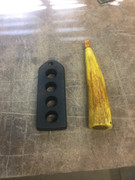Logcutter
40 Cal
I have two brass priming powder flasks. I had one. And it always leaked a little powder when I used FFFF. So I bought another. It leaked a little powder as well. Both put out about 3 grains a push. Neither of them loses powder when I put FFF in them. Guess the courser powder doesn't get by the seal. I don't really want to buy another because I'm guessing I may find the same thing.
Meanwhile the guy that has a shop where I buy most of my powder and such is telling me I don't even need FFFF powder. He always primes with FFF. I have tried priming with FFF and I have to admit I didn't have the miss fires I kind of expected.
Most guys I know prime with FFFF of course but I'd like to hear some opinions. Any body routinely priming with FFF? I admit the idea of one powder and being able to prime right from my horn sounds mighty attractive. But not at the costs of misfires.
I should add my flinters are .50 cal. rifles. No muskets.
Meanwhile the guy that has a shop where I buy most of my powder and such is telling me I don't even need FFFF powder. He always primes with FFF. I have tried priming with FFF and I have to admit I didn't have the miss fires I kind of expected.
Most guys I know prime with FFFF of course but I'd like to hear some opinions. Any body routinely priming with FFF? I admit the idea of one powder and being able to prime right from my horn sounds mighty attractive. But not at the costs of misfires.
I should add my flinters are .50 cal. rifles. No muskets.







